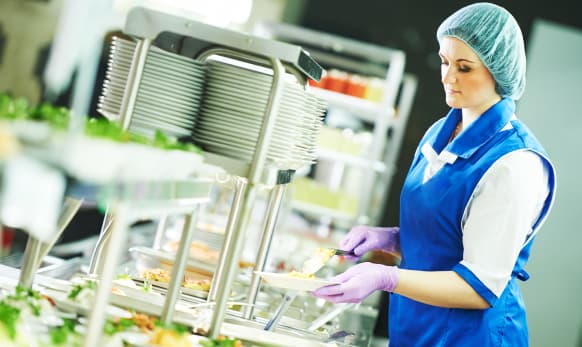School nutrition professionals in the U.S. prepare and serve healthy school meals for 30 million students every day, so it’s tough to find the time to implement green lunchroom initiatives.
For the average school, a huge portion of lunches end up in the trash along with plastic cutlery, Styrofoam trays, and other waste that is harmful to the environment. Food waste has cost U.S. schools billions of dollars over the past few decades.
K‑12 schools have a special role in reducing negative environmental impacts while educating the next generation about taking care of our planet.
If you want to make your lunchroom green, it’s time to brainstorm ways to redesign your sustainable school cafeteria. Here are five tips to get you started.
Serve Sustainable Foods in Your Green Lunchroom
Sustainability starts with the food you’re serving! Processed foods and low-quality meats are extremely carbon intensive. Replace these foods with fresh whenever possible. You get bonus points for organic ingredients!
Check out the National Farm to School Network to connect with area farmers to incorporate local food into your cafeteria.
Reduce and Recycle Single-Use Items
Think about how many students eat their meals off of polystyrene trays with plastic cutlery. That’s a lot of plastic that gets thrown out each day.
Switching from disposable trays and utensils to reusable ones reduces your waste tremendously after just one day. No dishwasher? No problem—there are many compostable alternatives on the market.
You can also get creative by upcycling some products. Milk cartons make great planters for growing your own ingredients and also work well for classroom crafts!
Go Paperless
Does your district send paper menus home with students each week or month?
All of that paper adds up quickly. Consider going paperless and moving your menus online for students and parents to access anytime from anywhere.
Digital menu boards are another green solution to implement in the lunchroom. Not only will digital menus keep you from wasting paper, but they’re also shown to increase program participation by engaging your tech-savvy students.
Start a School Garden
The most environmentally-friendly way to get food is to grow it yourself on-site. This helps you reduce that amount of processed foods in your lunchroom.
Plus, school gardens are a fantastic educational tool when you get students involved; students learn about where their food comes from and how to grow their own sustainable foods at home. Also, school gardens naturally encourage teamwork amongst students.
Keep your garden nutrient-rich while reducing food waste by starting a composting program. Compost bins are a low-cost and low-maintenance option to efficiently transform your lunchroom waste. Even without a garden, you can still compost.
Check out the US Composting Council to find online resources on getting started in your state.
Reduce Food Waste While Serving Your Community
The USDA strongly encourages schools to donate leftover foods to appropriate nonprofit institutions, provided the practice is not prohibited by your state or local laws and regulations. Instead of throwing out excess wholesome food, collect it after meal times to donate to food pantries.
Share tables are also a great way to reduce waste. Students can place unopened milk cartons and packaged items they aren’t going to eat on the table to share with students who need it.
Build a Green Lunchroom Today
Allowing students to make conscious choices on how they use their waste can improve your school and your students’ attitudes.
When you incorporate actions to your nutrition program like food donations, share tables, a school garden, recycling, and composting, you show your students how to take care of the planet while being exceptional community members.
